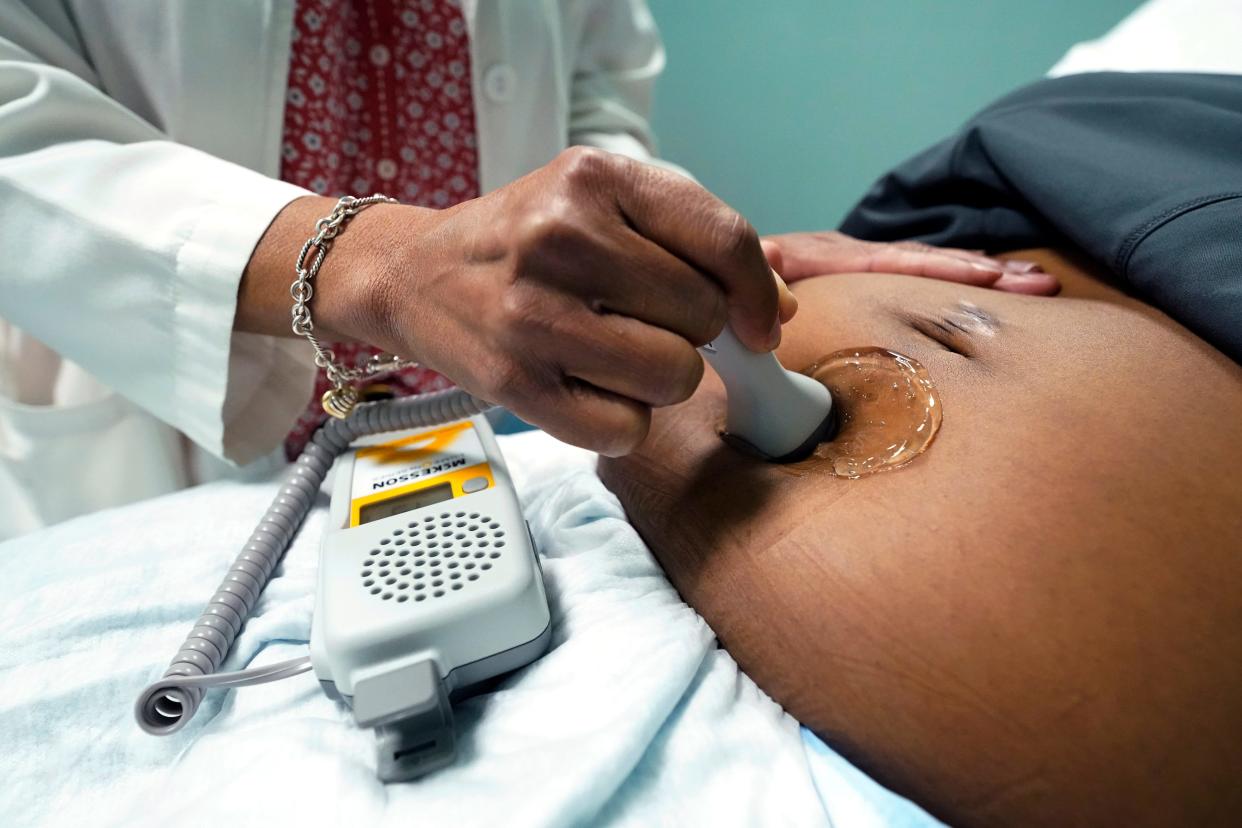NC Black babies have a higher death rate. We must help them survive.

Sometimes a full-blown crisis flies under the radar.
I am glad that is changing when it comes to the infant death rate for Black mothers. A light has been shone on the crisis at least.
But that light also reveals the situation is still very bad. And we can do better.
In the end, we must.
More: Meet the Fayetteville doula fighting to improve Black maternal health, infant mortality rates
Seventy percent of these infant deaths are preventable, said Michaela Penix, who lives in Fayetteville and recently served as North Carolina director for Maternal and Infant Health for the March of Dimes.
“That is part of the problem, folks have resigned themselves to believe that infant mortality is something that just happens,” she said.

September is National Infant Mortality Awareness Month. On Sept. 12, the Centers for Disease Control and Prevention reported that the infant mortality rate overall in 2021 remained relatively steady from the previous report. The mortality rate is the number of deaths of babies in the first year of life per 1,000 births.
A bleak trend for Black mothers continued: Their mortality rate was 10.6 per 1,000 births, more than twice that of white mothers.
The COVID-19 pandemic caused a spike in both the percentage of Black women who died during pregnancy or childbirth, as well as infant mortality, according to CDC reports released in the spring.
I asked Penix if society was going in the right direction in term of its awareness and response to the problem.
“Yes and no,” she said.
She said passage of Medicaid expansion by the N.C. General Assembly would improve care options for mothers after the birth of their child. Better prenatal care and a sharper focus on addressing underlying conditions that could lead to pregnancy complications are still needed, she said.

Penix recently started a new job as national director of Community Mobilization for March of Dimes. In that role, she works with fraternity Alpha Phi Alpha and sorority Zeta Phi Beta, both historically Black and longtime partners, on education programs on healthy living, including teen pregnancy prevention; awareness of premature births and healthcare access.
But better policies would help, she said.
“There are other pieces of play, too, like paid medical leave, paid maternity leave,” she said. “There are some people in our state who have to return back to work within two weeks of giving birth but because they cannot afford to take the time off.”
Cumberland County and the state — ‘similar’ distressing trends
I don't think it is difficult for anyone to see the crisis in infant mortality for Black women is directly tied to the crisis of Black maternal health. Figures show Black women are two to three times more likely to die from pregnancy complications than their white counterparts, according to CDC data.
Taken together, the twin crises seem to be a healthcare version of the old adage about economic woes in the U.S.: When the rest of the country catches a cold, African Americans get pneumonia.
A look at state and local number reveals the infant mortality crisis is close to home, affecting our friends and neighbors.

“In 2021, black babies in North Carolina were two times more likely to die in their first year than white babies,” Dr. Jennifer Green, the county Health Director, and Tamra Morris, deputy director, said in a joint statement in response to questions. They said they “see similar trends in Cumberland County.”
The health officials attribute the crisis to poorer prenatal care options. Green and Morris said that this year, 17% of North Carolinians seeking prenatal care reported the care was inadequate. Citing the most recent North Carolina Mortality Report, they said the deficit in prenatal care for Black women leads to more premature or preterm births, complications with chronic conditions and an increase in other health disparities.
“Social and economic factors continue to contribute to poor maternal and infant health outcomes particularly among Black women, and racial disparities reflect increased barriers to care for people of color,” the joint email said.
‘Unacceptable’ treatment during pregnancy care
The U.S. leads all other high-income nations in infant mortalities, according to a report by the Commonwealth Fund, which researches healthcare worldwide or in the U.S. and provides grants to promote better access.
After non-Hispanic Black women, the infant mortality rates by race and ethnicity are:
Non-Hispanic Native Hawaiian or other Pacific Islander: 7.8
Non-Hispanic American Indian/Alaska Native: 7.5
Hispanic: 4.8
Non-Hispanic white: 4.4
Non-Hispanic Asian: 3.7
So what accounts for the different outcomes? The CDC has found that it matters how expectant mothers are treated while receiving maternal care.
One in five women reported being scolded, threatened or mistreated by healthcare providers, with women of color reporting more cases of mistreatment, the agency said in findings released last month.
Dr. Debra Houry, chief medical officer for the CDC, called it “unacceptable,” according to a press briefing Aug. 22 that described a call Houry had with reporters.

She said: “We know mistreatment and discrimination can have a negative impact on the quality of maternity care. We have to encourage a culture of respectful maternity care. This should be part of greater efforts to improve quality by standardizing care to reduce complications and deaths related to pregnancy and delivery.”
We are not in a great place. We don’t have to stay there.
More than 20,000 infant deaths were reported nationwide in 2020; in North Carolina, that number was 803, placing the state eighth in the country in infant deaths.
The infant mortality rate statewide is 6.9; in Cumberland County, the figure was 9.8.
In 2020, Cumberland had 50 infant deaths, third in the state behind Mecklenburg (Charlotte) with 75 and Wake County (Raleigh) with 69. Durham County, which is similar in population size to Cumberland, had 25 deaths and the rate was 6.2.
So we are not in a great place right now as far as infant mortality goes. But we do not have to stay there, either.
County health officials have a target of reducing the infant mortality rate to 6 by 2030, according to a 2021 Community Health Assessment report.
Green and Morris said in their joint statement, “Reducing infant mortality begins with prenatal care and maternal health.”
The officials said the county health department offers a variety of services and programs, including:
— A Maternity Clinic that is a part of Women’s Health Services which offers low-risk prenatal care and delivery services for any pregnant Cumberland County resident.
— Prenatal education through group classes in the Maternity and Health Education Division. The next series is scheduled to begin in November.
— A Newborn Home Visit Program for moms and babies where a nurse visits at no cost to ensure mom and baby are doing well after they leave the hospital.
— A new service, the Connected Care Program, which is a collaborative effort between the Health Department and the Department of Social Services. It sends teams of social workers, health educators and community social services assistants to help individuals and families by identifying “addressing social determinants of health that contribute to health disparities.”
Doulas to the rescue?
Nonprofits and other agencies are stepping up. So is academia.
That is what we need: Partnerships.
The partnerships include Momma’s Village, owned by Angela Tatum Malloy, which is participating in a $10 million statewide study that will show how doulas like Malloy can reduce health care racial inequities that negatively impact Black mothers. Forty doula practices across the state will eventually be involved in the study, which got underway in 2021.
A major goal of the effort is to reduce instances of low birth weight, according to study co-authors Drs. Jennifer Tang and Rachel Urrutia of the Department of Obstetrics and Gynecology at UNC-Chapel Hill’s medical school.

“We know that one of the leading causes of infant mortality is low birth weight,” Tang said. “It is highly associated with preterm birth.”
The UNC researchers are studying how doula care impacts low birth weight as well as how detailed dashboard tracking of each patient's condition by clinic staff can make a difference.
Tang said discrimination and microaggressions that Black women may face during treatment or in their regular lives can negatively affect their pregnancy.
“We know that some of the chronic stress that people face is elevated during pregnancy,” she said. “There can be a lot of social or mental health changes. This is where the doulas can really play a part — doulas who are trained to support patients, who know were they are coming from, who can help reduce some of their anxiety, who can answer some of the basic questions and make sure they are getting connected to the best resources.”
She said a study in Greensboro showed that patients who had community-based doulas were four times less likely to have a low birth weight infant, than those who did not have a doula, "which is huge. Because it is very, very actually hard to reduce low birth weight.”
She said a different study showed that a clinic's data practices and use of dashboards and an alert system were found to be effective, too.
“What's important to emphasize is all patients benefitted,” Tang said. “The white patients benefitted, they improved, as well as the Black patients.”
Myron B. Pitts can be reached at mpitts@fayobserver.com or 910-486-3559.

This article originally appeared on The Fayetteville Observer: Black moms in Fayetteville and NC are losing babies. These are solutions

